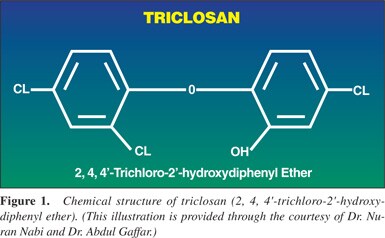Advanced Oral Antibacterial/Anti-inflammatory Technology: A Comprehensive Review of the Clinical Benefits of a Triclosan/Copolymer/Fluoride Dentifrice
Fotinos S. Panagakos, DMD, PhD Anthony R. Volpe, DDS, MS Margaret E. Petrone, JD, William DeVizio, DMD Robin M. Davies, BDS, PhD: Colgate-Palmolive Technology Center, Piscataway, NJ, USA. Howard M. Proskin, PhD: Howard M. Proskin and Associates Rochester, NY, USA
Abstract
- Introduction: Triclosan is a broad-spectrum antibacterial agent, marketed for use in oral products. It is effective against both grampositive and gram-negative bacteria. PVM/MA is the non-proprietary designation for a polyvinylmethyl ether maleic acid copolymer. It has been demonstrated that there is a greater uptake of triclosan to enamel and buccal epithelial cells from the use of a fluoride dentifrice containing triclosan and the PVM/MA copolymer than from a dentifrice containing triclosan alone. This Supplement details the results of antibacterial, anti-inflammatory, and short- and long-term plaque and gingivitis studies with a triclosan/copolymer/ fluoride dentifrice. Additionally, the Supplement reviews studies on the effect of a triclosan/copolymer/fluoride dentifrice on periodontitis, calculus, caries, whitening and stain removal, oral malodor, and on the microflora.
- Conclusion: Clinical studies indicate that the use of a triclosan/copolymer/fluoride dentifrice (Colgate® Total® Toothpaste) may provide oral health benefits beyond those associated with "traditional" toothpaste use, in a manner that is safe and effective. Studies presented in this Supplement demonstrate that Colgate Total Toothpaste provides superior protection against plaque and gingivitis, caries, oral malodor, exhibits superior stain removal, and provides protection against the progression of periodontal disease.
(J Clin Dent 16 (Supplement)
Introduction
Triclosan
Triclosan is a broad-spectrum antibacterial agent, marketed for use in oral products under the tradename Irgacare MP®, and manufactured by the Ciba-Geigy
The primary site of triclosan's antimicrobial action is the bacterial cytoplasmic membrane. Triclosan prevents essential amino acid uptake at bacteriostatic concentrations. At bactericidal concentrations, triclosan causes cytoplasmic disorganization of the bacterial cytoplasmic
 Triclosan is widely used as an antibacterial agent in such over-the-counter products as deodorant soap bars, liquid soaps and underarm deodorants that are sold in most countries of the world.3 Antibacterial skin products containing triclosan are utilized in hospitals.4
Triclosan is widely used as an antibacterial agent in such over-the-counter products as deodorant soap bars, liquid soaps and underarm deodorants that are sold in most countries of the world.3 Antibacterial skin products containing triclosan are utilized in hospitals.4
As summarized by Lindhe,5 triclosan is a useful antibacterial agent to be incorporated into oral products because it has a broad spectrum of activity on oral bacteria, is compatible with the ingredients in oral products, and has a long history of safe use in consumer products. After reviewing all the pharmacological and toxicological information available in 1989, DeSalva, Kong
